ZHCSGN9D February 2016 – March 2018 LM36274
PRODUCTION DATA.
- 1 特性
- 2 应用
- 3 说明
- 4 修订历史记录
- 5 Pin Configuration and Functions
- 6 Specifications
-
7 Detailed Description
- 7.1 Overview
- 7.2 Functional Block Diagram
- 7.3
Features Description
- 7.3.1 Enabling the LM36274
- 7.3.2 Backlight
- 7.3.3 LCM Bias
- 7.3.4 Software Reset
- 7.3.5 HWEN Input
- 7.3.6 Thermal Shutdown (TSD)
- 7.4 Device Functional Modes
- 7.5 Programming
- 7.6
Register Maps
- 7.6.1 Revision Register (Address = 0x01)[Reset = 0x01]
- 7.6.2 Backlight Configuration1 Register (Address = 0x02)[Reset = 0x28]
- 7.6.3 Backlight Configuration 2 Register (Address = 0x03)[Reset = 0x8D]
- 7.6.4 Backlight Brightness LSB Register (Address = 0x04)[Reset = 0x07]
- 7.6.5 Backlight Brightness MSB Register (Address = 0x05)[Reset = 0xFF]
- 7.6.6 Backlight Auto-Frequency Low Threshold Register (Address = 0x06)[Reset = 0x00]
- 7.6.7 Backlight Auto-Frequency High Threshold Register (Address = 0x07)[Reset = 0x00]
- 7.6.8 Backlight Enable Register (Address = 0x08)[Reset = 0x00]
- 7.6.9 Bias Configuration 1 Register (Address = 0x09)[Reset = 0x18]
- 7.6.10 Bias Configuration 2 register (Address = 0x0A)[Reset = 0x11]
- 7.6.11 Bias Configuration 3 Register (Address = 0x0B)[Reset = 0x00]
- 7.6.12 LCM Boost Bias Register (Address = 0x0C)[Reset = 0x28]
- 7.6.13 VPOS Bias Register (Address = 0x0D)[Reset = 0x1E]
- 7.6.14 VNEG Bias Register (Address = 0x0E)[Reset = 0x1C]
- 7.6.15 Flags Register (Address = 0x0F)[Reset = 0x00]
- 7.6.16 Option 1 Register (Address = 0x10)[Reset = 0x06]
- 7.6.17 Option 2 Register (Address = 0x11)[Reset = 0x35]
- 7.6.18 PWM-to-Digital Code Readback LSB Register (Address = 0x12)[Reset = 0x00]
- 7.6.19 PWM-to-Digital Code Readback MSB Register (Address = 0x13)[Reset = 0x00]
- 8 Application and Implementation
- 9 Power Supply Recommendations
- 10Layout
- 11器件和文档支持
- 12机械、封装和可订购信息
8.2.3.2 LCM Bias Curves
Ambient temperature is 25°C and VIN is 3.7 V unless otherwise noted. VPOS, VNEG and VPOS/VNEG efficiency is defined as POUT / PIN, where POUT is actual power consumed in VPOS, VNEG and (VPOS + VNEG) outputs, respectively. External components are from Table 30.
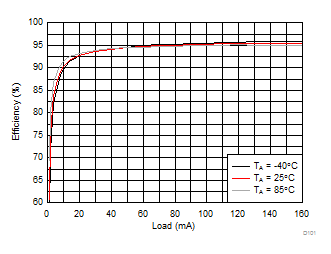
| VLCM_OUT = 4.3 V |
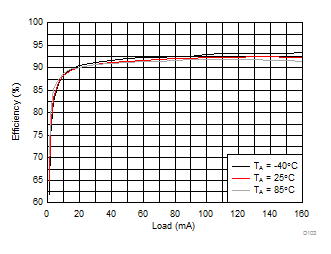
| VLCM_OUT = 6.3 V |
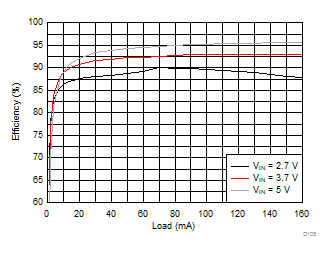
| VLCM_OUT = 5.8 V |
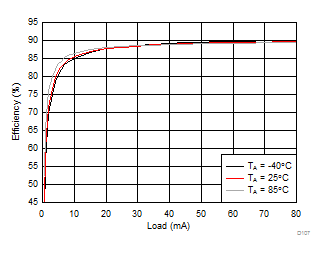
| VVPOS = 4 V | VLCM_OUT = 4.3 V |
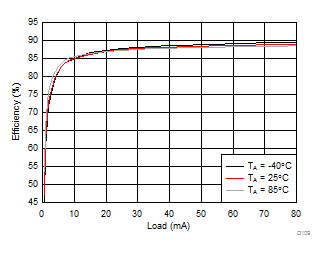
| VVPOS = 6 V | VLCM_OUT = 6.3 V |
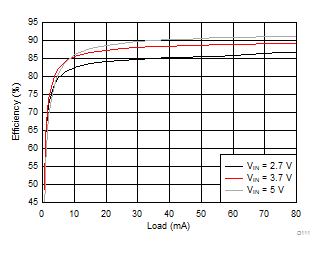
| VVPOS = 6 V | VLCM_OUT = 6.3 V |
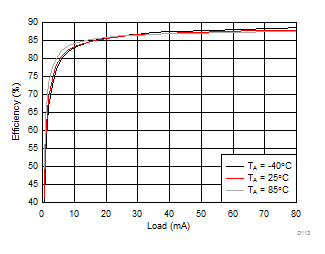
| VVNEG = -4 V | VLCM_OUT = 4.3 V |
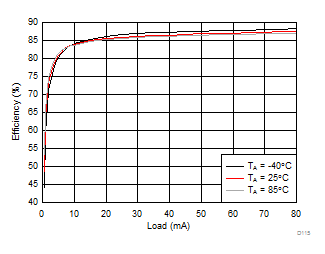
| VVNEG = -6 V | VLCM_OUT = 6.3 V |
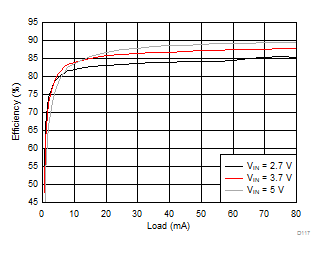
| VVNEG = –5.5 V | VLCM_OUT = 5.8 V |
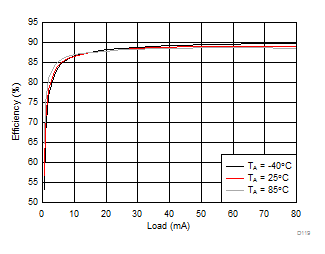
| VVPOS = 4 V | VVNEG = –4 V | VLCM_OUT = 4.3 V |
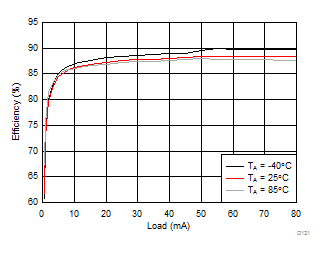
| VVPOS = 6 V | VVNEG = –6 V | VLCM_OUT = 6.3 V |
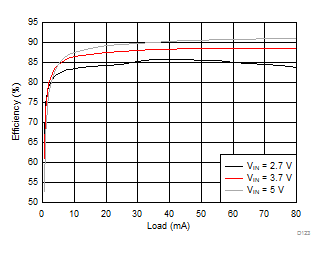
| VVPOS = 5.5 V | VVNEG = –5.5 V | VLCM_OUT = 5.8 V |
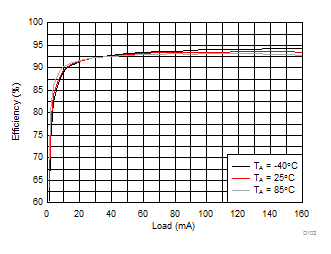
| VLCM_OUT = 5.3 V |
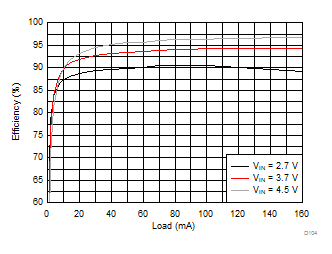
| VLCM_OUT = 4.8 V |
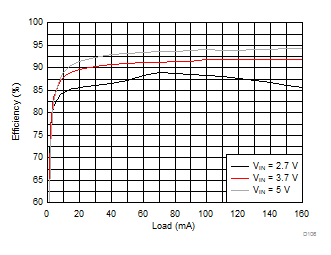
| VLCM_OUT = 6.8 V |
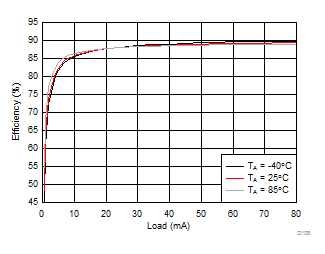
| VVPOS = 5 V | VLCM_OUT = 5.3 V |
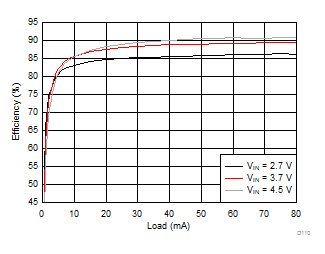
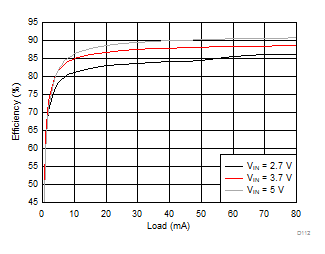
| VVPOS = 6.5 V | VLCM_OUT = 6.8 V |
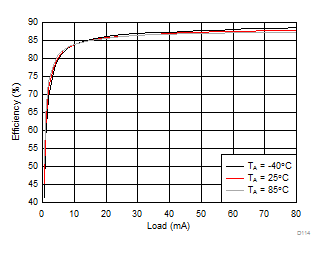
| VVNEG = -5 V | VLCM_OUT = 5.3 V |
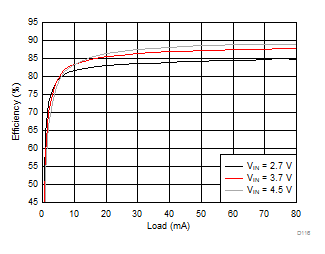
| VVNEG = –4.5 V | VLCM_OUT = 4.8 V |
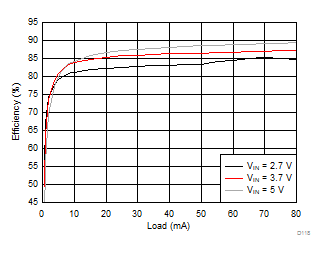
| VVNEG = –6.5 V | VLCM_OUT = 6.8 V |
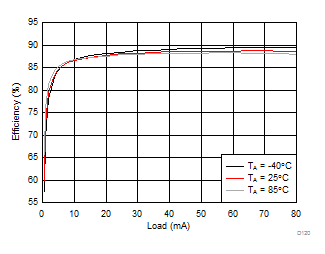
| VVPOS = 5 V | VVNEG = –5 V | VLCM_OUT = 5.3 V |
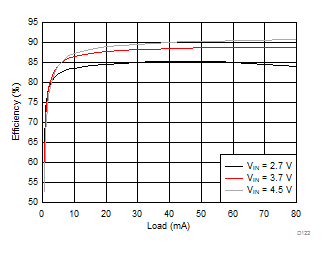
| VVPOS = 4.5 V | VVNEG = –4.5 V | VLCM_OUT = 4.8 V |
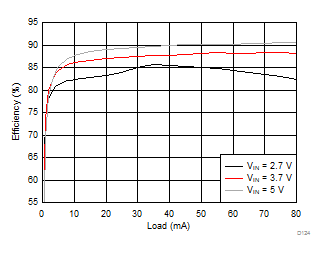
| VVPOS = 6.5 V | VVNEG = –6.5 V | VLCM_OUT = 6.8 V |